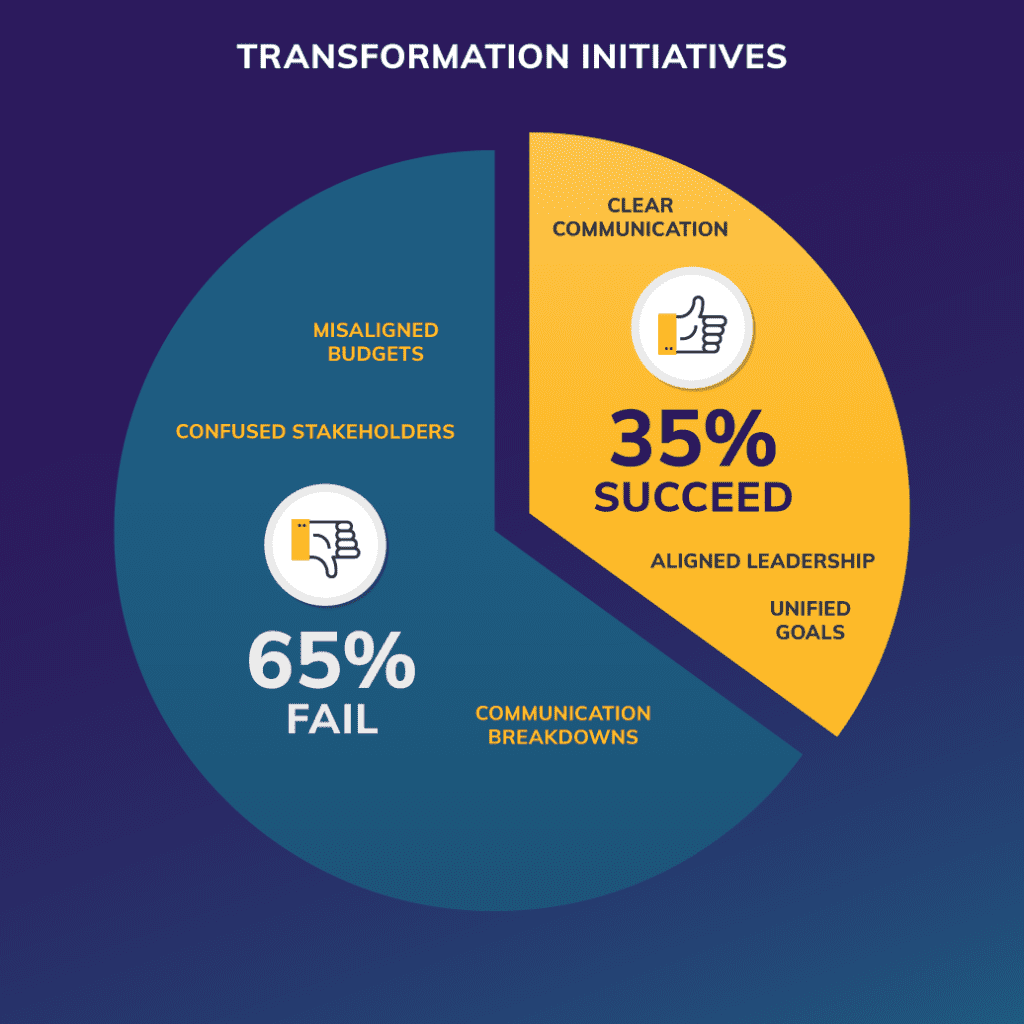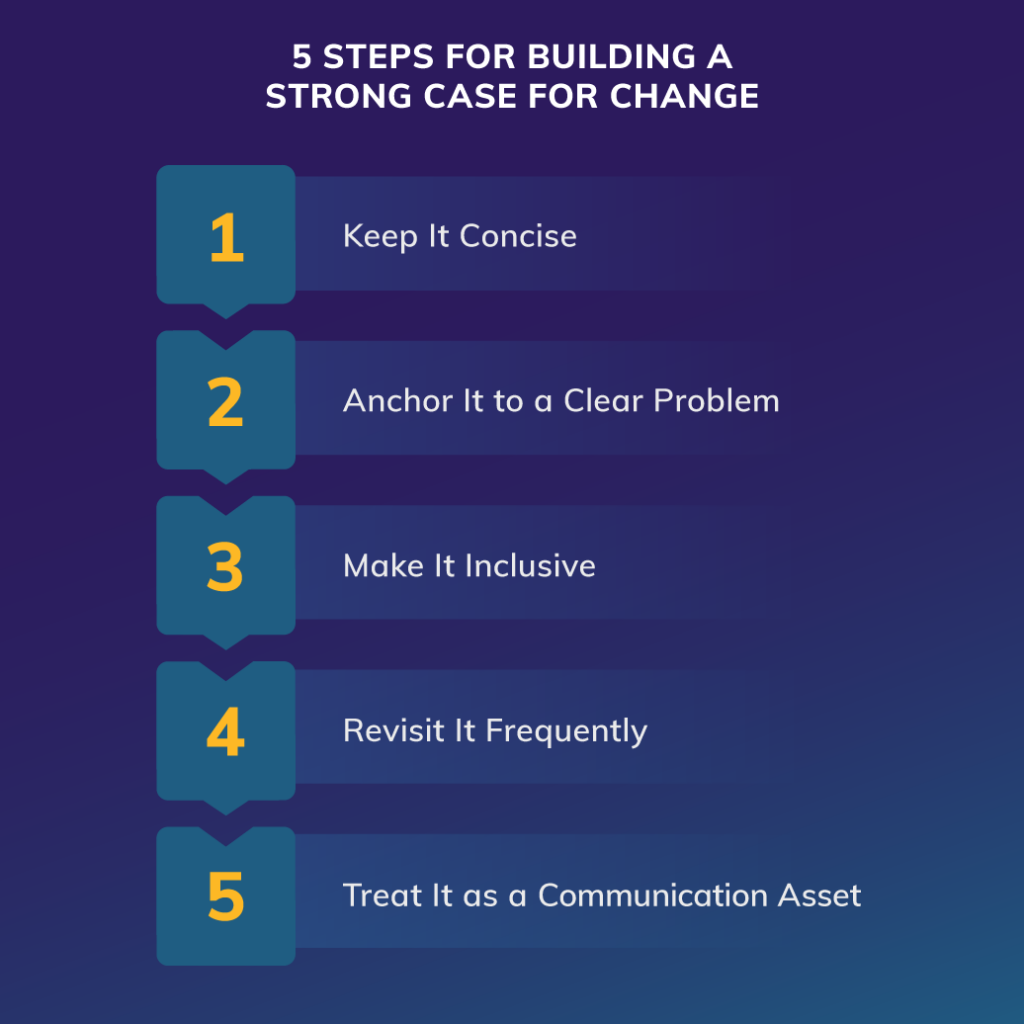A lack of communication is one of the biggest barriers to new projects and business transformation. Learn what a case for change is and how it builds awareness, creates support, and minimizes resistance so your project runs smoothly.
In brief:
- Only 35 percent of transformation initiatives succeed, with lack of alignment on goals being a major failure point.
- A concise, shared case for change defines your “why,” aligns leadership, and helps every team member understand the purpose of transformation.
- Without a clear case for change, your project will struggle with budgets, buy-in, communication and coordination.
A clear, shared case for change is the most important asset you can create for any transformation initiative. Whether launching a new technology platform, evolving your business model, or realigning core processes, this foundation defines your why, aligns your leaders, and helps every team member see where you’re going and why it matters.
According to a 2023 Harvard Business Review article, only 35 percent of transformation initiatives succeed — and one of the most common failure points is a lack of clarity and alignment on what the organizational change is meant to achieve. Without a case for change, everything becomes more difficult: budgets, buy-in, communication, even basic coordination.
Many teams dive into execution without first asking the fundamental questions: Why now? What problem are we solving? What will successful change look like? This problem is more common than you think. Strategic change initiatives often stall due to unclear alignment at the top. When asked to see the case for change, there either isn’t one, or each leader had a different version in their head.
“Assuming that everybody has the same why is often a derailment,” says Verna Montgomery, my colleague and people and change expert. “I’ve seen CIOs and CFOs operate from completely different versions of the case for change — one focused on people, the other on cost — and neither of them knew it until it was too late.”
So what makes a good case for change, and how can you write one that keeps your project on track from day one?
What Is a Case for Change?
A strong case for change is both a strategic document and a leadership test. As Bea Grause, president of the Healthcare Association of New York State, recently emphasized in a call to action for the healthcare industry, making the case for change requires honesty and vision.
Her message? Suppose your organization faces workforce shortages, market shifts, or persistent operational strain. In that case, you can’t afford to talk around the problem — you have to name it, explain it, and unify your teams around it.
What all goes into a case for change? The one-page, plain-language statement should clearly explain:
- What is happening?
- Why is it happening?
- What are the benefits?
- When is it happening?
- Who is impacted?
- What do we expect to see as a result?
It should be something anyone in the organization can read and understand without further explanation. It should stand on its own, provide clarity, and act as a north star throughout the life of the project.
“It’s the lens through which every decision must pass,” says Montgomery. “If something doesn’t support the case for change, you need to question why it’s happening.”
A strong case for change also becomes the backbone of your change management story. It informs executive updates, employee town halls, and manager toolkits. It can be used in sales decks, vendor communications, and board reports. It’s not just a document — it’s the message.
And yet, far too often, organizations skip this step and pay the price.
Why Projects Fall Apart Without One
According to Oak Engage’s 2023 Change Report, 29 percent of employees report that organizational changes are not communicated clearly. This lack of clarity can lead to confusion, resistance, and, ultimately, the failure of change initiatives.
When you skip the case for change, you lose more than a communication tool — you lose alignment.
We worked with one client whose leadership team insisted they were fully aligned on the goals of a transformation. But when we sat down with them to write a case for change, every leader gave a different answer. As a result, their PMO was overextended, business stakeholders were misinformed, and budgets were misallocated.
“You end up with a different ROI for every stakeholder,” says Mongomery. “And eventually, it all falls apart.”
In another case, a client was already executing against a roadmap, but no one could explain why certain projects were prioritized over others. Once we paused and brought the team together to define a compelling, shared case for change, the confusion cleared. Projects were reshaped, budgets were reallocated, and communication improved overnight.
The presence or absence of a case for change isn’t only about communication. It’s about whether your team is set up to succeed. So, how do you build one?
5 Steps for Building a Strong Case for Change
A well-crafted case for change isn’t written by a single executive in a vacuum. It should be built collaboratively, pressure-tested by leadership, and shared widely.
Here are five best practices to guide the process:
1. Keep It Concise
Limit your case to one page, but don’t mistake brevity for lack of impact. The most effective change case documents are anchored in clarity and repetition. Your case should include three to four sentences that could be repeated: an elevator pitch. When everyone in the organization hears the same message, they’ll start to align around it.
2. Anchor It to a Clear Problem
Start with what you’re solving. This grounds the rationale for the project and creates urgency. It also helps people understand the value of the change, especially when competing priorities emerge. The case for change should incorporate the problem you’re solving, your approach, and the macro-level outcome you expect to see. This format keeps the narrative honest and goal-oriented.
3. Make It Inclusive
Don’t write your case in a vacuum or delegate it entirely to one function. The most effective cases are co-created with input from sponsors, functional leaders, and those on the ground — in fact, according to Gartner, organizations that implement such open-source change strategies are 14 times more likely to achieve successful outcomes. If leaders can’t agree on the “why,” that’s a red flag. We’ve seen transformations stall because the CFO, CHRO and CIO all had different reasons for the same project, and no shared case to bring them back together.
4. Revisit It Frequently
A case for change is not a set-it-and-forget-it document. It should be revisited at every major milestone or pivot. Start your project reviews or steering committee decks with a simple reminder: “Remember, this is our case for change.” Doing so reinforces accountability and helps surface misalignment before it turns into rework.
5. Treat It as a Communication Asset
The change case document isn’t only a planning tool — it’s a communication tool, too. It should show up in talking points, town halls, stakeholder presentations, and onboarding materials. Repetition matters. The marketing rule of seven applies even internally — the idea that a customer, or, in this case, a team member, needs to see a message seven to 10 times to retain the information. Make sure what they hear is consistent, compelling and easy to recall.
Getting your case for change right doesn’t make your project easier — it makes it possible.
You Can’t Afford to Skip the Case for Change
If you skip the case for change, you’re almost guaranteed to stumble. It’s not just about alignment. It’s about credibility. It’s about execution. It’s about trust.
Imagine launching a major transformation without a case for your change initiative. Your sponsors assume they’re aligned, but in reality, they’re working from different goals. Your project team doesn’t know what successful change looks like. Your employees are left wondering why they’re being asked to change at all.
Imagine starting with a single, shared statement that makes the why unmistakable.
That’s how you drive alignment. That’s how you build momentum.
That’s how you lead a change that actually sticks.
Change is inevitable, but successful transformation requires more than just a project-by-project approach. We specialize in Enterprise Change Management (ECM) — enabling your organization to enable change and create a competitive advantage. Skip frustrated employees, missed opportunities, and a lack of sustainable transformation by working with ECM experts to drive your organization toward change. Learn more



